
克劳德•莫奈(Claude Monet),大运河(Le Grand Canal),1908年,油画画布73×92厘米,摩洛哥Nahmad Collection ©作品收藏者/Claude Monet, The Grand Canal (Le Grand Canal), 1908, Oil on canvas 73 × 92 cm Nahmad Collection, Monaco © Photo courtesy of the owner
“莫奈与建筑”展-馆长首推的五幅作品
Monet and Architecture exhibition curator picks five must-see paintings
由专筑网王帅,李韧编译
当前,在伦敦国家美术馆举办的展览汇集了78幅法国印象派艺术家克劳德•莫奈(Claude Monet)的作品,这些作品主题与建筑相关。馆长Rosalind McKever特意挑选出一些代表性的作品。
莫奈最负盛名的作品是对于自然的表达,特别是其“睡莲(Water Lily)”系列,而本次展览” Credit Suisse Exhibition”的主题为:莫奈&建筑(Monet & Architecture),关注了莫奈在建筑方面的艺术造诣。
在接受Dezeen的记者采访时,McKever认为,莫奈的这些作品关注于建筑环境,这些理念“与直觉相反”,但它们表达了艺术家的工作方式。
画展上作品按类型排列,而不是时间。这样一来,参观者就可以一起回顾莫奈职业生涯中所阐释的那些建筑项目。
McKever说:“我从工作中真正学到了两件事,那就是思考其构图与绘画方式。”
她补充道:“通过将两个非常相似的作品放在一起,其中的差异表明,他可能不会如你所期望的那样记录他面前的场景,实际上他是用自己的方式进行了创作。”
“另一件非常重要的事情是他的绘图能力,这位画风自由的艺术家,他可以很轻松的绘画出流畅的线条,例如,他可以画出一座非常清晰的桥梁。”
这些画作分为三个部分,很好地阐述了莫奈一生与建筑的交集,它们分别是“乡村和风景”(The Village and The Picturesque)、“都市和现代”(The City and The Modern)和“纪念和神秘”(The Monument and The Mysterious)。
这次展览中既有公共作品,也有私人作品。这些画作是自莫奈创作以来,第一次以一个系列的主题进行展出。
在夏季的展览上,只有五幅作品来自国家美术馆,其余的都是从世界各地的博物馆、画廊和私人收藏品租赁而来。这个创意归功于爱丁堡大学的著名莫奈研究学者Richard Thompson教授。
在此,McKever挑选出了她最喜欢的五幅画,以此再现十九世纪的欧洲建筑:
An exhibition at London's National Gallery brings together 78 paintings by French impressionist artist Claude Monet that explore works of architecture. Curator Rosalind McKever selects her highlights.
While Monet is most famous for his depictions of the natural world, particularly his Water Lily series, The Credit Suisse Exhibition: Monet & Architecture turns its attention to the artist's representation of architecture.
In an interview with Dezeen, McKever described the concept of focusing on works where Monet focused on the built environment as "a really counterintuitive idea" – but one that proved illuminating in how it revealed the way the artist worked.
Rather than arranged chronologically, the paintings are hung according to subject matter, so the buildings and locations Monet returned to over his career can be seen together.
"The two things I've really learnt from working in this way is thinking about how much he is playing with space and playing with what we are seeing," said McKever.
"By putting together two very similar works the differences between them emphasise how he may actually be not, as you would expect, documenting the scene before him, but actually creating a composition out of the forms that he sees," she added.
"The other thing that comes through very strongly is his ability as a draughtsman. In terms of an artist who we may think of painting very freely, he can actually paint a straight line – very freely – as well as the kinds of squiggles that you get with the Water Lilies. He can paint, for example, a bridge with incredibly clarity and spacial understanding."
The paintings are divided into three sections to better explore how Monet engaged with architecture throughout his life: The Village and The Picturesque, The City and The Modern and The Monument and The Mysterious.
The exhibition draws on works from both public and private collections. In some instances this is the first time certain paintings in a series have been together since they were in the artist's studio.
Only five of the total paintings in the blockbuster summer exhibition, which was the brainchild of leading Monet scholar, professor Richard Thompson from the University of Edinburgh, are from the National Gallery's collection. The rest are on loan from museums, galleries and private collections from around the world.
Here, with what she describes as great difficulty, McKever picks her five favourite paintings (or, in one case, series of paintings) and describes how they highlight the architecture of 19th-century Europe:
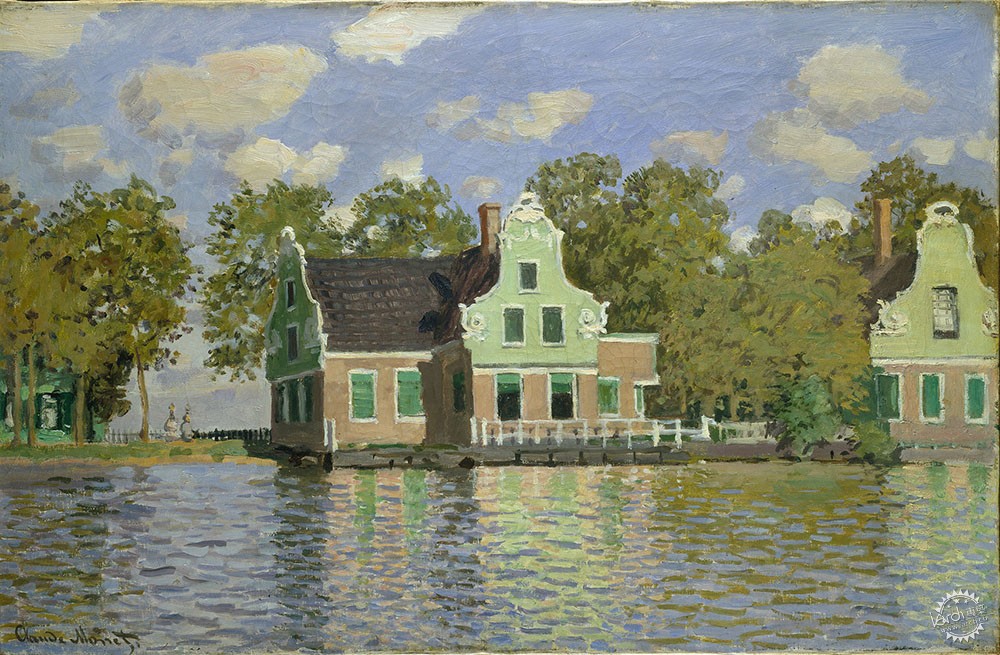
克劳德•莫奈,赞丹赞河旁的房,赞丹,1871年,油画,施塔德尔艺术馆,Frankfurt am Main (1385)/Claude Monet, Houses on the Banks of the Zaan, Zaandam, 1871, Oil on canvas, Städelsches Kunstinstitut, Frankfurt am Main (1385)
Windmills near Zaandam,克劳德•莫奈,1871年,来自阿姆斯特丹(荷兰首都)梵高博物馆(Van Gogh Museum)
McKever说:“我觉得这个作品很有趣,因为人们不熟悉莫奈在荷兰创作的作品。”“Windmills near Zaandam”属于“乡村和风景”系列的一幅作品。
1871年,为了躲避法国与普鲁士的战争,莫奈从伦敦来到荷兰,参观了风景如画的荷兰赞丹(Zaandam),他发现了令人赏心悦目的景色。
莫奈职业生涯中最明显的两大主题是互补的色彩和水中的倒影。在这幅画里,粉绿相间的建筑倒映在波光粼粼的水面上,这是他早期的代表作品。
McKever解释说:“如果你看图面下半部分,你可以感受到空间色彩的倒映,因此,水面的色彩成为了混合着蓝、绿、粉的奇妙结合。”
“这是他职业生涯中一个有趣的时刻,因为其创作于印象派风格诞生之前,我们可以肯定地看到,这部作品是印象派风格的起源。”
Windmills near Zaandam, Claude Monet, 1871, from Van Gogh Museum, Amsterdam
"This one I thought is interesting because people are not as familiar with the work Monet made in the Netherlands," said McKever. Windmills near Zandaam is from the first part of the exhibition, The Village and The Picturesque.
Travelling back from London, where he had taken refuge during the Franco-Prussian War, in 1871 Monet visited the Zaandam in the Netherlands. Trained in the aesthetic ideal of the Picturesque, the artist sought out views pleasing to the eye.
Two big themes that became apparent in Monet's work throughout his career are complimentary colours and reflections in water. This painting, where the reflection of the pink and green house is given almost as much space on the canvas as the structure itself, is an early example of this.
"If you look at the bottom half you can see how the colours from the top half a reflected in the bottom, so the reflection of the house becomes this very complicated mix of blues and then mint greens and peaches,' explained McKever.
"This is an interesting moment in his career because this is before the first Impressionist exhibition, but we can certainly see in this work the beginnings of the style that would come to be known as Impressionism."
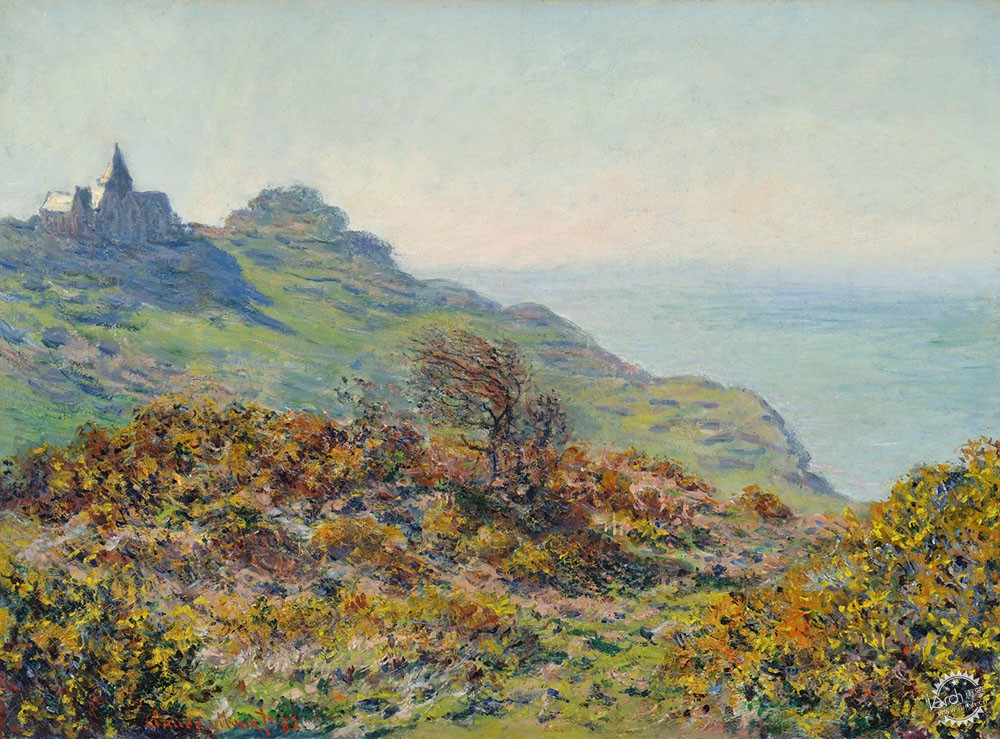
克劳德•莫奈,The Church at Varengeville and the Gorge of Moutiers,1882年,油画,哥伦布艺术博物馆,Arthur J Kobacker夫妇的礼物/Claude Monet, The Church at Varengeville and the Gorge of Moutiers, 1882, Oil on canvas, Columbus Museum of Art, gift of Mr and Mrs Arthur J Kobacker
The Church at Varengeville and the Gorge of Moutiers,1882年
在这里,莫奈回到他成长的地方,诺曼底的海岸,他画了一座教堂,教堂边的陆地渐渐消失在海面上,建筑完全融入自然。
McKever说:“从根本上来说,他是一位大自然的画家,但是为了最好地展现自然,他通过建筑与之形成对比。”
她补充说:“坐落在悬崖顶端的教堂拥有独揽群山的气势。通过周围悬崖的对比,你可以感受到教堂的宏伟,以及对于大自然的敬畏。”
景观中的建筑形成了对比,使莫奈展示他对画作和印象派风格的把控能力。
McKever说:“当在这些沿海环境中加入建筑时,能够让矩形硬边体量与下面弯弯曲曲的悬崖形成鲜明的对比。这样就有真正的并列表达,强调建筑的挺拔和悬崖的险峻。”
The Church at Varengeville and the Gorge of Moutiers, 1882
Here Monet is back on the coast of Normandy where he was raised, painting a church that sits where the land sheers away into the sea, and the built environment gives way to nature.
"He is fundamentally a painter of nature, but in order to best show nature he is showing it using the contrast of the built environment," said McKever.
"You have this church that's perched on the top of the cliff, which gives it a sense of scale," she added. "You get a sense of how big that would be and therefore how big the cliff below it would be. That sense of awe at nature really requires that."
Architecture in the landscape provides a contrast that allows Monet to display his command of his medium and the Impressionist style.
"When he's using buildings in these coastal environments, with the church you have a very square, structured buildings with loads of straight lines, as opposed to the cliffs below, which are far more ragged," said McKever. "You have this real juxtaposition that emphasises both the structure of the building and the ruggedness of the cliff."
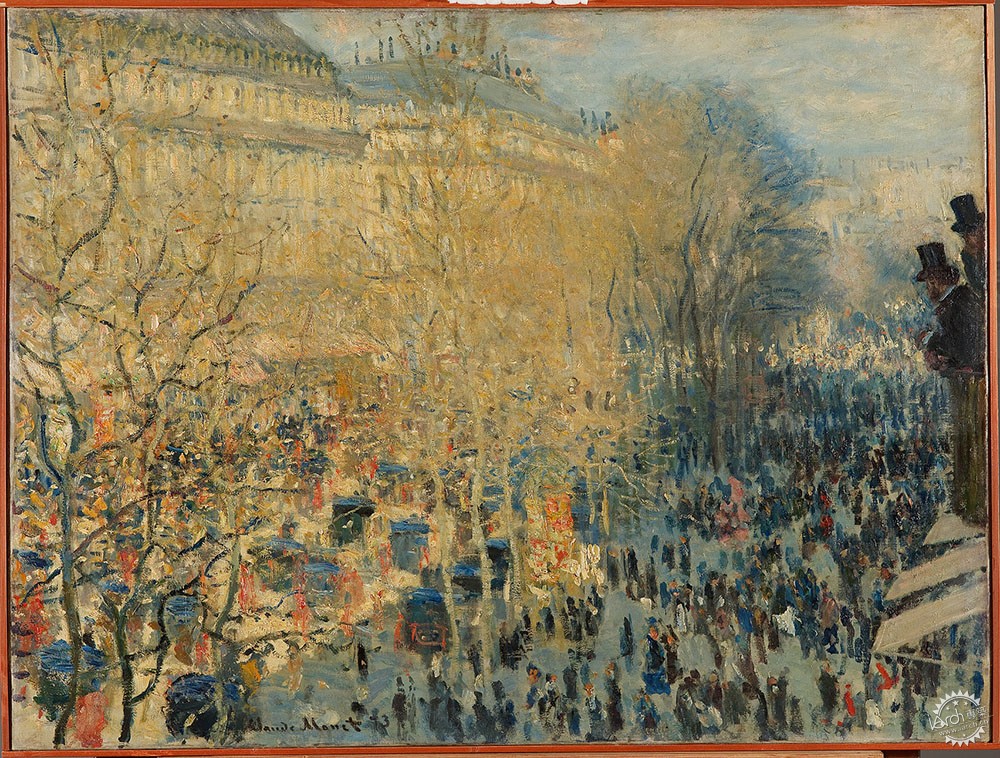
克劳德•莫奈,卡普辛大街(The Boulevard des Capucines),巴黎,1873年,油画,国家普希金美术馆,莫斯科(3397)Artothek/Claude Monet, The Boulevard des Capucines, Paris, 1873, Oil on canvas, The State Pushkin Museum of Fine Arts, Moscow (3397) Artothek
卡普辛大街,巴黎,1873年
这幅画属于“都市和现代”系列,描绘了1873年巴黎的一条街道。
McKever说:“这是巴黎城市发展的重要时刻,油画创造时间为Haussmannisation时期(始于1852年的巴黎改造开始)之后,这时诞生了很多新建筑。”
“这条卡普辛大街不仅是Hausmannian建筑的一个典例,也是莫奈作为印象派画家的一大代表。”
这幅画作的创作时间是巴黎第一次印象派艺术展览之前,创作地点位于法国摄影师纳达尔(Nadar)的房间内,那里正是举办展览的地方。
McKever说:“这幅画有趣的地方是明确的对角线,在那里你可以看到画面中的建筑物的阴影和建筑的高光部分,整个画面似乎快要溶解,莫奈简直是光线的剧作者。”
“你无法区分树木和街道,因为所有的元素都混杂在一起。”
The Boulevard des Capucines, Paris, 1873
This painting, displayed in The City and The Modern part of the exhibition, depicts a street in Paris in 1873.
"This is an important moment in Paris' development as a city, in the period following Haussmannisation," said McKever. "It's architecturally new."
"This Boulevard de Capucines is not only a good example of Hausmannian architecture but of Monet as an Impressionist painter."
The canvas was in fact painted just one year before the first exhibition of Impressionist art in Paris, in the very room – belonging to the French photographer Nadar – where the display would be held.
"What's interesting about this painting is there's a really strong diagonal where you get the shadow of the building that cuts all the way across the canvas, and in the golden section of the composition where the sun is strongest – and Monet is fundamentally a painter of light – the picture almost dissolves," said McKever.
"You can't really tell the difference between the trees and the architecture of the street because everything has come together."
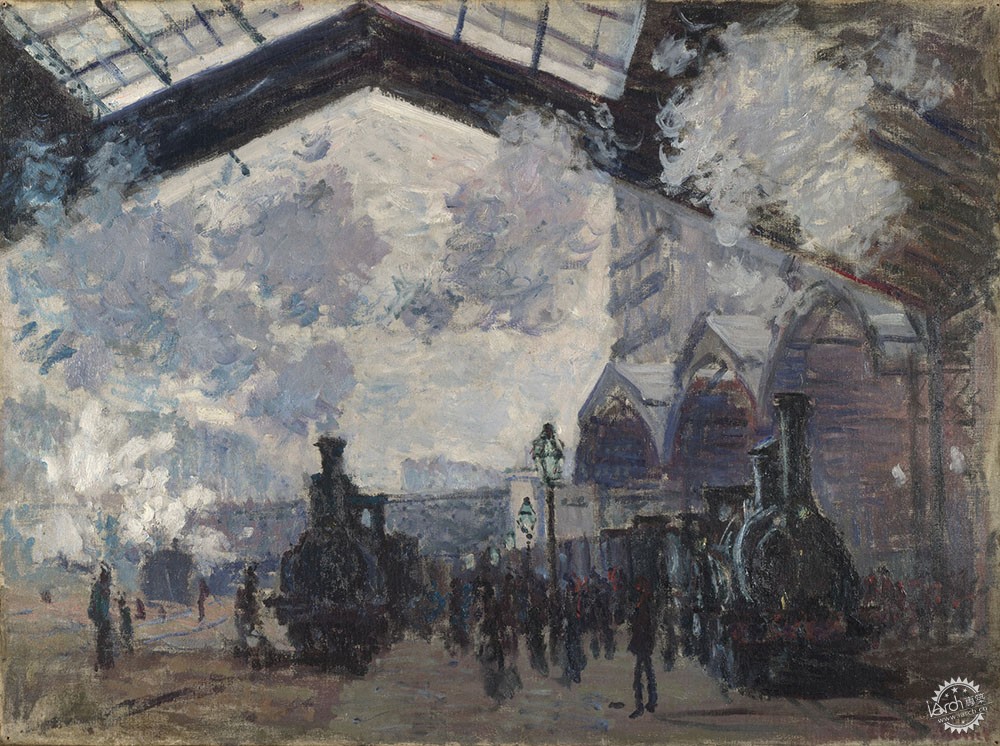
克劳德•莫奈,圣·拉扎尔火车站(La Gare Saint-Lazare),1877年,油画,伦敦国家美术馆/Claude Monet, The Saint-Lazare Railway Station (La Gare Saint-Lazare), 1877, Oil on canvas, The National Gallery, London
圣·拉扎尔火车站,1877年
McKever解释说:“火车对莫奈来说非常重要,因为火车带着莫奈达到他想要去的地方。”
莫奈对这个火车站总共进行了12次创作,他租了一套隔壁的公寓专门用于绘画。圣·拉扎尔火车站建于1837年,在五六十年代进行了一次扩建,这在当时是一座相当现代的建筑。
McKever说:“在这幅画中,你可以清楚地看到建筑的屋顶,以及上部铁和玻璃结构。”
“如果你认为莫奈是一位风景画家,你会期望画面的上方看到天空。而在这幅作品上,上部结构色彩却非常暗沉,还有发动机中冒出的烟雾和蒸汽,而不是云彩。”
The Saint-Lazare Railway Station, 1877
"Trains are very important for Monet. Many of the places he's going he's travelling to via train," explained McKever.
In total Monet painted La Gare Saint-Lazare 12 times, renting an apartment next door especially to paint the building. Built in 1837, an expanded during the 50s and 60s, it was a fairly modern building for the time.
"You can see very clearly in this painting the roof of the building, this iron and glass structure above, and the clarity of that," said McKever.
"If you think of Monet as a landscape painter you'd expect at the top of the canvas to find the sky, but instead you find this very dark structure, and instead of clouds you get these puffs of smoke and steam coming from the engines."
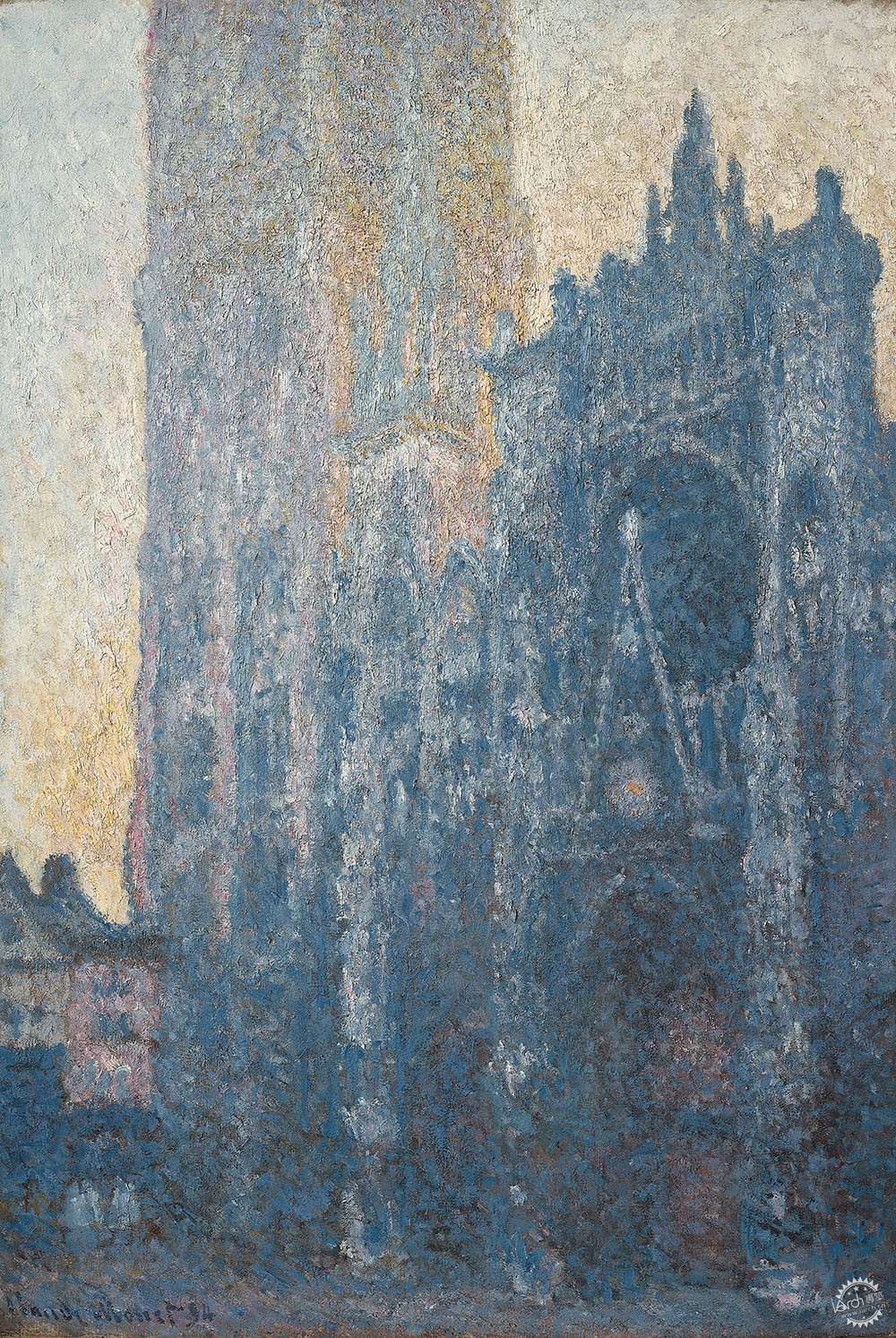
克劳德•莫奈,鲁昂大教堂:门户(Rouen Cathedral: The Portal),1894年,油画,Fondation Beyeler,Riehen/Basel/Claude Monet, Rouen Cathedral: The Portal (Morning Effect (Cathédrale de Rouen: Le Portail (Effet du matin)), 1894, Oil on canvas, Fondation Beyeler, Riehen/Basel. Photograph is by Robert Bayer
鲁昂大教堂:门户(Rouen Cathedral: The Portal),1894年
这是莫奈的这些作品的第一次展出,国家美术馆买下了鲁昂大教堂系列中的五幅画,并将它们挂在一堵墙上。
McKever说:“这是展览中最令人兴奋的部分,这就是他开始真正捕捉到一系列短暂的瞬间。他通过众多画布来表现同一事物。”
在1892年到1894年间,莫奈在不同的光线和天气条件下挑战教堂的创作,他租了很多房子来获得不同的视角,甚至有女更衣室。
McKever解释说:“从他的描述中你可以看出,他很努力地在完成这些作品。莫奈在他的临时工作室里布置了多种画布,便于他在光线变换或天气转好时进行不同的创作。”
“在这座教堂中,他没有直接运用直线,而是通过光影关系进行表达,这样你得到的是光效应的累积,而不是建筑的线条。”
瑞士信贷展览会(The Credit Suisse Exhibition):“莫奈&建筑(Monet & Architecture)”在伦敦国家美术馆展出,截止时间为2018年7月29日。
Rouen Cathedral: The Portal (Morning Effect), 1894
For the first time since Monet initially exhibited the series together, the National Gallery has bought together five of the paintings in his Rouen Cathedral series and hung them on one wall.
"This is one of the most exciting bits of the exhibition," said McKever. "This is when he starts trying to really capture not just one fleeting moment but a series of fleeting moments, by painting numerous canvases of the same thing."
Between 1892 and 1894 Monet challenged himself to paint the Cathedral in Normandy under many different light and weather conditions, renting apartments to gain different perspectives and even, in one case, the changing room of a ladies clothes shop.
"From his letters you can tell that it's a real effort for him," explained McKever. Monet set up multiple canvases in his makeshift studios, so that he could switch between them as the light shifted or the weather turned.
"What he's actively trying to do with Rouen Cathedral is paint architecture without any lines. He's trying to capture the effect of light on the facade of the building so that what you get is a cumulation of light effects rather than the straight lines of the building."
The Credit Suisse Exhibition: Monet & Architecture runs until 29 July 2018 at the National Gallery, London.
出处:本文译自www.dezeen.com/,转载请注明出处。
|
|
